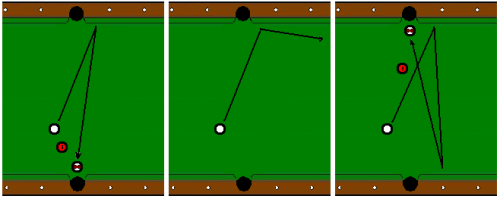The Angle of Reflection
Hello World! Sorry for the tardy post, I’ve been in bed for two days sick, but hey baby, I’m back! Since I’m a day behind, I’ll do two posts today. I’ll start with the Angle of Reflection, then later today when hopefully I feel a little better, I’ll write about the next topic, Speed after Collision.
So here we go…the Angle of Reflection. When a cue ball rolls toward a cushion, hits the cushion and rebounds back, how do we predict the angle the cue ball will take when it leaves the cushion? That seems like an easy thing to predict, huh? Well, in some ways it is. The generally accepted rule of thumb for predicting the angle of rebound goes something like this: “The angle of incidence equals the angle of reflection.” This is a concept borrowed from classical physics. Although this approach is very accurate when applied to light waves or other forms of electromagnetic radiation (with little or no mass), this rule of thumb can be highly influenced by other forces when applied to a real world setting that is filled with rolling and spinning spheres of significant mass.

Figure 1
Let’s start simple. In figure 1, I show the classic concept from physics, where the angle of incidence equals the angle of reflection. This is actually a very accurate guideline for predicting the path of a cue ball bouncing off a rail under the following three conditions: (1) if the cue ball is rolling naturally (not over spinning, sliding, or rotating backwards), (2) if the cue ball has a very slight horizontal rotation to it (in this case, a slight right spin, also known as “Running English”), and (3) if the cue ball is hit with normal speed (between 3 and 7 on the Arm Calibration scale from my November 10, 2009 post). Under these three conditions, the angle of reflection will almost exactly equal the angle of incidence. However, if you vary any of these three factors, the angle of reflection will be modified from the theoretical value. How much will it be modified? Unfortunately, you have to go to the table and experiment with these factors to get a feel for how much they influence the rebound angle.
Here are the general rules for determining the influence of these factors:
1. For very large angles of incidence (the cue ball is approaching the rail at a shallow angle), the angle of rebound will be even shallower than the theoretical value (more oblique). Conversely, for shots into the rail that are nearly perpendicular, the rebound will be even more perpendicular (more acute) than theory suggests.
2. If you hit the cue ball hard, the angle of rebound will be sharper (more acute). For cue balls hit really soft, the angle will be fatter (more oblique).
3. Cue ball rotational at the time of impact has a MASSIVE affect on rebound angle. This motion can be present in two forms: (1) Forward/Backward rotation, and (2) Side Spin (commonly referred to as Spin or English). As an example, in Figure 1 above, if the cue ball was rolling forward and had a hard right spin, the cue ball would come off the rail at an angle much more oblique (more parallel to the rail) than expected. Conversely, on the same shot if the ball had backward rotation and/or hard left spin, the angle of rebound would be modified to be much more perpendicular to the rail than theory would suggest.
OK, sounds interesting (or maybe not), but how much do I really need to worry about this? If you want to be able to predict the path of the cue ball, you need to develop a good feel for how much influence these factors have. What’s the worst that can happen? Just for fun, I’ve included some graphs below that demonstrate some of the most extreme examples of shots that I’ve seen that deviate from the “angle of incidence = angle of reflection” rule of thumb. All of these shots are possible, given changes in the three factors that I mentioned above: the angle of incidence, speed of the shot, and rotational spin. Don’t believe it? Yes, these are extreme examples, but they are possible. Maybe in a future post I’ll go into a little more detail on how these shots are performed.

Examples of deviant Angles of Reflection
Later today, I’ll post the final technical installment called Speed after Collision. Then Saturday I’ll wrap up the series and show you how to apply these concepts in a real game.





